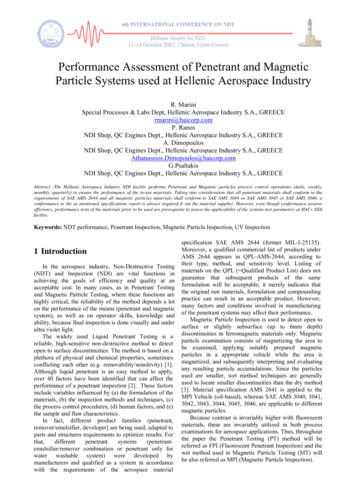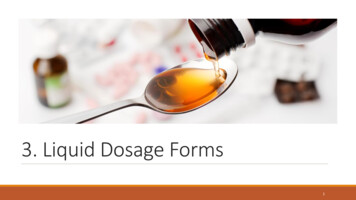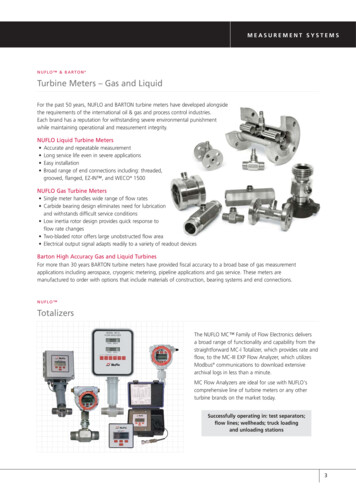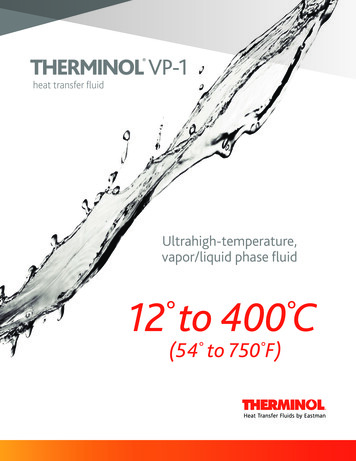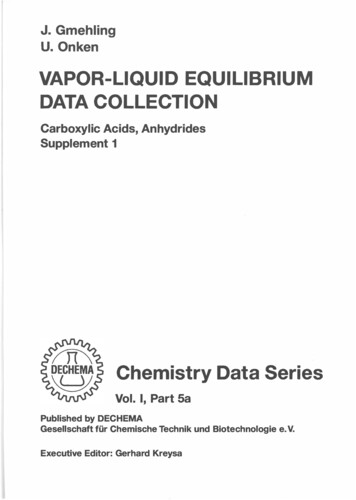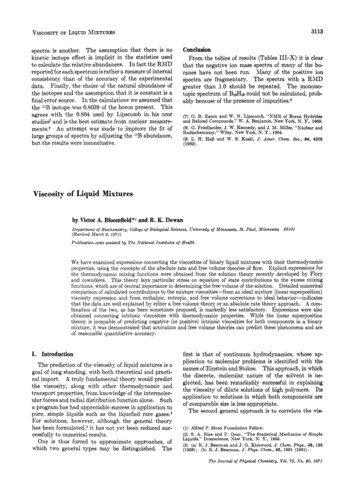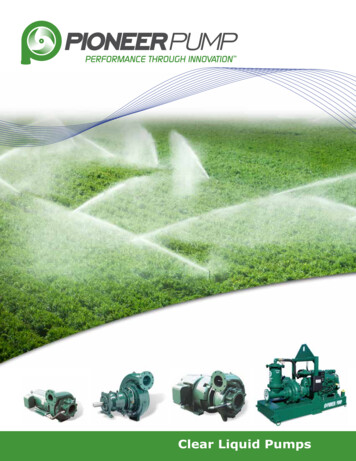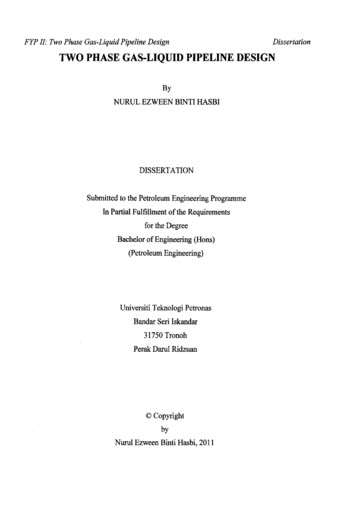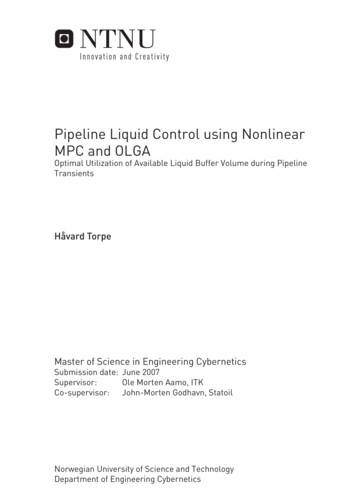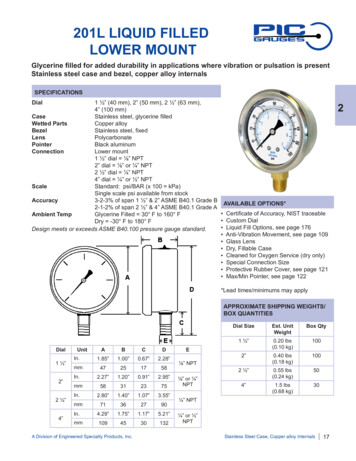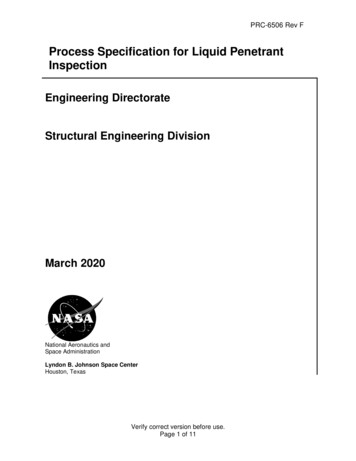
Transcription
PRC-6506 Rev FProcess Specification for Liquid PenetrantInspectionEngineering DirectorateStructural Engineering DivisionMarch 2020National Aeronautics andSpace AdministrationLyndon B. Johnson Space CenterHouston, TexasVerify correct version before use.Page 1 of 11
PRC-6506 Rev. FProcess Specification for Liquid PenetrantInspectionRevised andReviewed by:Revised andReviewed by:Revised andReviewed by:Revised andReviewed by:Approved by:Signature on FileAjay KoshtiMaterials and Processes Branch/ES401/07/2020DateSignature on FileDavid StanleyMaterials and Processes Branch/ES401/07/2020DateSignature on FileNorman RuffinoMaterials and Processes Branch/ES401/07/2020DateSignature on FileMiles SkowMaterials and Processes Branch/ES401/07/2020DateSignature on FileBrian MayeauxMaterials and Processes Branch/ES401/21/2020DateVerify correct version before use.Page 2 of 11
PRC-6506 Rev. FREVISIONSVERSIONBaselineCHANGESDATEOriginal version7/22/99AReviewed document per QMS requirements. Updateddivision name, organization codes, and documentnumbers.12/19/02BUpdated the Qualified Products List document numberand title.1/14/05CAddition of NASA-STD-5009 and NASA-STD-50199/25/06DAddition of PRC-5010 for part etching before penetrantinspection04/02/08EAdded SNT-TC-1A to paragraph 4.0. Revisedparagraph 9.0 for uniformity across all NDE PRCs.Reviewed document per QMS requirements. Updatedsignatures and organization codes. Minor Changes.Added requirements for Standard dye penetrant tomatch with NASA-STD-5009B. 2.0 Applicability –added cracks and pores. 3.2 Added electro-polishing inaccordance with PRC-5009. 6.1 General – addedStandard Liquid Penetrant inspection, sensitivity Level3 or 4 fluorescent penetrant shall be used. The “ascast” surfaces of welds and additively manufacturedparts are considered to be undisturbed and do notrequire pre-penetrant etching unless the surface issubsequently mechanically smeared. 6.3 ViewingArea – changed black light intensity shall be aminimum of 1000 W/cm2 at the examination surface10.0 Definitions – Added Standard NDE6/29/2011FVerify correct version before use.Page 3 of 1103/25/2020
PRC-6506 Rev. F1.0SCOPEThis process specification establishes the minimum requirements for liquidpenetrant inspection of nonporous metal and nonmetal components.2.0APPLICABILITYThis specification is applicable to in-process, final, and in-service liquid penetrantinspections to detect discontinuities such as cracks and pores that are open to thepart surface.3.0USAGEThis specification shall be invoked by an inspection note on the applicableengineering drawing or by reference in a Process Specification, Task PerformanceSheet, Discrepancy Report/Material Review Record, or other appropriate workauthorizing document. At a minimum, the inspection note shall specify theinspection Type (Section 3.3) and Level (Section 3.4).The engineering drawing or referencing document shall specify the criteria bywhich components are judged acceptable. Where acceptance criteria are nototherwise specified the criteria in Section 3.6 shall apply. Other acceptancecriteria, such as those in MIL-STD-1907, may be used as appropriate. When thereare different acceptance criteria for different areas on a component, the drawingshall be zoned with the acceptance criteria identified for each zone. If the numberof components to be inspected and the amount of coverage of each component isnot specified, all components shall be examined and shall receive 100 percentliquid penetrant coverage.Typical liquid penetrant inspection notes for flight hardware and critical groundequipment are given below.PERFORM LIQUID PENETRANT INSPECTION PER JSC PRC6506, TYPE I, LEVEL 3.Above note is for using the default acceptance criteria given in Section 3.6.Verify correct version before use.Page 4 of 11
PRC-6506 Rev. FPERFORM LIQUID PENETRANT INSPECTION PER JSC PRC-6506,TYPE I, LEVEL 3. ACCEPTANCE CRITERIA PER MIL-STD-1907,GRADE A.Above inspection note invokes MIL-STD-1907 for acceptance criteria.Liquid penetrant inspection notes in any work authorizing document shall bepreceded by a note for pre-penetrant etching or electro-polishing, whichever isappropriate, unless exempted. See section 3.2 for further requirements onetching or electropolishing.3.1INSPECTION SEQUENCEThe stage in the manufacturing process where liquid penetrant inspection isperformed should be specified on the engineering drawing or in the referencingdocument. Final liquid penetrant inspection shall be performed after completion ofall manufacturing operations that can generate surface discontinuities or exposeexisting subsurface discontinuities. These operations include, but are not limitedto, grinding, welding, straightening, machining, and heat treating.Final penetrant inspection may be performed before surface treatments that do notby themselves generate surface discontinuities. These surface treatments include,but are not limited to, vapor blasting, grit blasting, bead blasting, sanding, buffing,polishing, lapping, and peening.Final penetrant inspection shall be performed prior to application of any surfacefinish or coating such as anodize, paint, or plating.3.2ELECTROPOLISHING AND ETCHINGAll mechanically disturbed surfaces shall be electropolished in accordance withPRC-5009 or etched in accordance with PRC-5010 to remove smeared metal priorto final penetrant inspection. Processes that mechanically disturb the surfaceinclude, but are not limited to, machining, vapor blasting, grit blasting, beadblasting, sanding, buffing, polishing, lapping, peening, deburring, wire brushing,and grinding. A minimum of 0.0004 inch of metal shall be removed from nonferrousmetals such as aluminum and titanium. A minimum of 0.0002 inch of metal shallbe removed from steels, stainless steels, and nickel-based alloys. Etching forpenetrant inspection in accordance with other process specifications must beapproved by the NASA JSC Materials and Processes Branch.Verify correct version before use.Page 5 of 11
PRC-6506 Rev. FParts with close tolerance surfaces or fine surface finishes that cannot be etchedmay be rough machined to within 0.030 inch or less of the final dimension, etched,liquid penetrant inspected, and then finish machined. Fracture critical parts shallbe re-inspected without electropolishing or etching after finish machining.Parts shall be electropolished or etched and penetrant inspected prior to drilling.Electropolishing or etching and inspection of the holes after drilling is not required.However, this does not apply when the load is transmitted through a single holesuch as in a lug. All such holes shall be either etched and penetrant inspected orinspected using an alternative method.3.3TYPESThe “Type” designator governs the type of liquid penetrant used and shall bespecified in the inspection note on the basis of the following definitions:a.b.Type I – Fluorescent dyeType II – Visible dyeOnly Type I (fluorescent dye) penetrant shall be used for final inspection of flighthardware.3.4LEVELSThe "Level" designator governs the sensitivity of Type I penetrant systems andshall be specified in the inspection note on the basis of the following definitions:a.b.c.d.e.Level 1/2 — Very LowLevel 1 — LowLevel 2 — Medium.Level 3 — High.Level 4 — Ultrahigh.Only sensitivity Level 3 or 4 penetrant materials shall be used for final inspectionof flight hardware.3.5SPECIAL NDE OF FRACTURE CRITICAL COMPONENTSWhen implementation of fracture control requirements necessitates SpecialNondestructive Evaluation (NDE) of a fracture critical component, the requirementfor Special NDE shall appear in the inspection note as shown below. When SpecialNDE is required, the specific inspection procedure and inspector shall be qualifiedin accordance with Section 7.0.Verify correct version before use.Page 6 of 11
PRC-6506 Rev. FPERFORM LIQUID PENETRANT INSPECTION PER JSC PRC-6506,TYPE I, LEVEL 3. SPECIAL NDE CERTIFICATION REQUIRED.3.6ACCEPTANCE CRITERIAThe engineering drawing or referencing document shall indicate the criteria bywhich components are judged acceptable. Where acceptance criteria are nototherwise specified the following criteria shall apply:a.Linear indications – all linear indications, regardless of length, shall because for rejection of the component.b.Single rounded indications – a single rounded indication greater than0.030 inches in diameter shall be cause for rejection of the component.c.Multiple rounded indications - two or more rounded indications each lessthan 0.030 inches in diameter but separated by less than 0.030 inches shallbe cause for rejection of the component.4.0REFERENCESThe following specifications, standards, and handbooks form a part of thisdocument to the extent specified herein. All documents listed are assumed to bethe current revision unless a specific revision is listed. In the case of conflictbetween this specification and the technical requirements cited in other referenceddocuments, the requirements of this document take precedence.ASTM E 1417Standard Practice for Liquid Penetrant ExaminationMIL-STD-1907Inspection, Liquid Penetrant and Magnetic Particle,Soundness Requirements for Materials, Parts, andWeldmentsNASA-STD-5009Nondestructive Evaluation Requirements for FractureCritical Metallic ComponentsNAS 410NAS Certification & Qualification of NondestructiveTest PersonnelQPL-AMS2644-4Qualified Products List of Products Qualified UnderSAE Aerospace Material Specification AMS 2644,Inspection Material, PenetrantVerify correct version before use.Page 7 of 11
PRC-6506 Rev. FSNT-TC-1APersonnelQualificationNondestructive TestingandCertificationinPRC-5009Process Specification forCorrosion-Resistant SteelElectropolishingofPRC-5010Process Specification for Pickling, Etching, andDescaling of MetalsThe following references were used to develop this process specification:SOP-007.1Preparation and Revision of Process Specifications(PRC’s)JPR 8500.4Engineering Drawing System Requirements5.0MATERIAL REQUIREMENTSOnly materials listed or approved for listing on QPL-AMS2644-4 shall be used forpenetrant inspection.6.0PROCESS REQUIREMENTS6.1GENERALLiquid penetrant examinations shall be performed in accordance with ASTM E1417 except as modified by this specification. For Standard Liquid Penetrantinspection, sensitivity Level 3 or 4 fluorescent penetrant shall be used. The “ascast” surfaces of welds and additively manufactured parts are considered to beundisturbed and do not require pre-penetrant etching unless the surface issubsequently mechanically smeared.6.2WRITTEN PROCEDURESA detailed written procedure shall be prepared for each part to be inspected. Theprocedure shall meet the requirements of this specification and shall ensure theconsistency and reproducibility of the inspection at the required sensitivity level.General procedures covering a variety different parts may be used provided theymeet the requirements of this specification and clearly apply to the parts to beinspected. When general procedures are used, a written part specific techniqueshall be prepared. At a minimum, the part specific procedure or the generalprocedure and part specific technique shall cover all of the information required byASTM E1417.Verify correct version before use.Page 8 of 11
PRC-6506 Rev. FFor work performed at JSC facilities, written procedures should consist of DetailedProcess Instructions (DPIs) selected for use from the DPI-6506-XX series of workinstructions.6.3VIEWING AREASFor Type I liquid penetrant inspections the black light intensity shall be a minimumof 1000 W/cm2 at the examination surface. The visible light background shall notexceed 2 fc (20 lx) at the examination surface for both stationary and portable TypeI inspections.6.4INDICATION REMOVALLocal areas that are sanded, ground, or machined to remove discontinuityindications shall be etched prior to the final inspection. Etching is not required forintermediate inspections performed during the removal process. Removal ofdiscontinuity indications shall be approved by the responsible engineeringorganization.6.5FRACTURE CRITICAL COMPONENTSLiquid penetrant inspections of fracture critical components shall be performed inaccordance with the process requirements of NASA-STD-5009. The requirementsin NASA-STD-5009 not otherwise covered in this specification are included in thefollowing:a.Examination surfaces must be easily accessible with no sharp rootrecesses and a surface roughness of 125 µin RMS or better.b.Evaluation of questionable indications by wiping the indication with asolvent dampened swap, drying, and redeveloping is not acceptable. Therelevance of questionable indications shall be evaluated by cleaning andreprocessing the component.When Special NDE is specified by the engineering drawing or referencingdocument, the inspection procedure and inspector shall be qualified in accordancewith Section 7.0.7.0 SPECIAL NDE QUALIFICATIONUse of Special NDE in accordance with NASA-STD-5009 requires formaldemonstration of the capability to detect flaws at least as small as the critical initialcrack size for the specific component to a 90/95 detection level. Each procedure,procedure application, and operator must demonstrate the requiredVerify correct version before use.Page 9 of 11
PRC-6506 Rev. Fcapability. Requests for Special NDE certification shall be directed to the JSCMaterials and Processes Branch (ES4).8.0DEVIATIONS AND WAIVERSAny deviations or waivers regarding the use of this process specification shall berequested in writing. This request shall be directed to the JSC Materials andProcesses Branch (ES4) with the appropriate justification and rationale. A writtenresponse will be provided upon such a request.9.0TRAINING AND CERTIFICATION OF PERSONNELPersonnel performing acceptance inspections of Class I, II, IIIW and GSEhardware shall be qualified and certified, at a minimum, to Level 2 in accordancewith NAS 410. Personnel performing acceptance inspections requiring S
ASTM E 1417 Standard Practice for Liquid Penetrant Examination MIL-STD-1907 Inspection, Liquid Penetrant and Magnetic Particle, Soundness Requirements for Materials, Parts, and Weldments NASA-STD-5009 Nondestructive Evaluation Requirements for Fracture Critical Metallic Components NAS 410 NAS Certification & Qualification of Nondestructive
